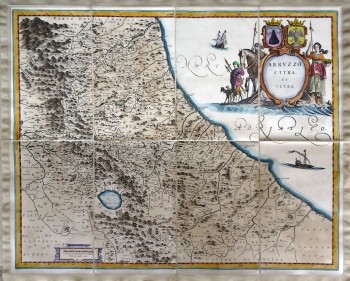
To view a larger image, please click here or hover over the photo above.
Author: J. Blaeu
Year/Period: 1640
| Size: | Inches: | 41 x 32 |
| CM: | 105 X 82 |
Price: $639.99
SKU: REG 133
Other Images:
Description:
Abruzzo Citra or Abruzzo Citeriore was a province of the Kingdom of Naples established by Charles of Anjou on the year 1273 when he divided Giustizierato of Abruzzo (founded by Frederick II) into two parts: Ultra flumen Aprutium Piscariae (Aprutium beyond the Pescara river (north of it)) and Aprutium citra flumen Piscariae (Aprutium South East side of the Pescara river).
Abruzzo Citra was located south of the Pescara river and within the area of today’s Abruzzo region of Italy, for the most part within the present Province of Chieti; the seat was the city of Chieti.
Abruzzo Ultra with seat to Aquila was located to the north of Pescara river and the borders of "the giustizierato" embraced the area of today’s provinces of Aquila, Teramo ,and for the most part within the present Provinces of Pescara and besides a partial North East side of the nowadays province of Rieti.
The borders of all the territory were on the north the Tronto river,to the south the Pescara river, and to the north east the mountains chain of the Gran Saaso.
The Blaeu family ran one of the most renowned Dutch publishing house during the seventeenth century, specialized in the printing of geographical books, nautical maps and atlases.The Blaeu printing works are especially known for the publication in 1669 of four large mural maps representing Europe, the Americas, Asia and Africa. This map shows Abruzzo Citra which was an administrative unit of the Regno di Sicilia, then of Regno di Napoli and finally of the Regno delle Due Sicilie. Map is characterized by a large cartouche in upper right corner.
Engraving Information:
This artistic reproduction of a vintage map was made using modern graphic procedures, but obtaining the results found in the antique copperplate engraving technique, as one can easily find out by lightly rubbing his/her finger on the map. This map, which is an exact reproduction of the original antique, is printed on cotton paper panels which are glued and mounted on a cotton cloth background "a stacchi" (slightly separated from each other), in order to allow for folding and easier transport. Finally, map is water-colored by hand making it a truly unique piece, worthy of the original old print.
Useful Links (provided by Wikipedia):
Useful Link 1






